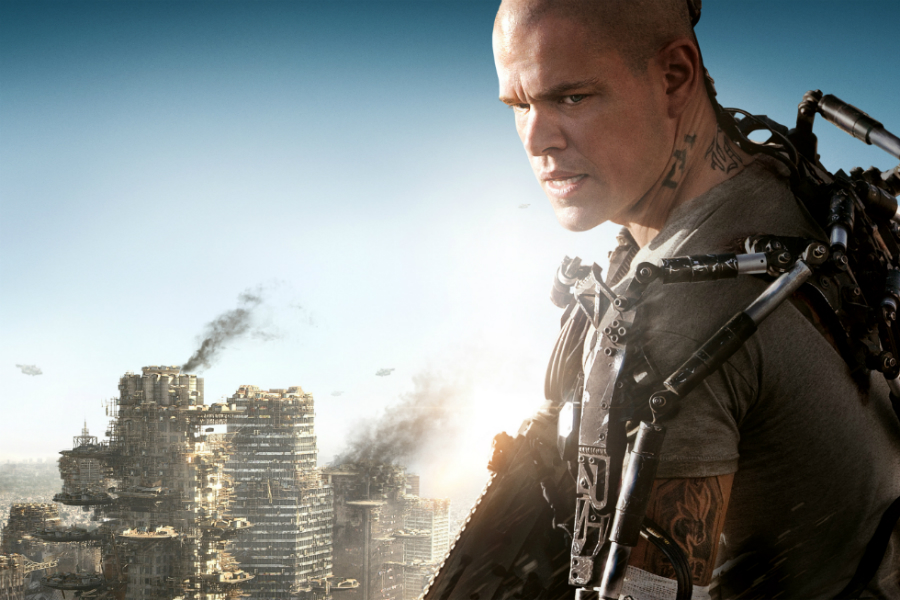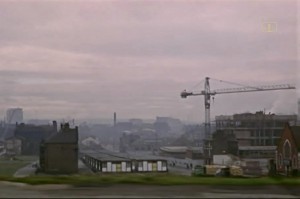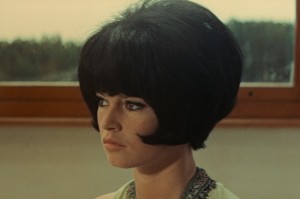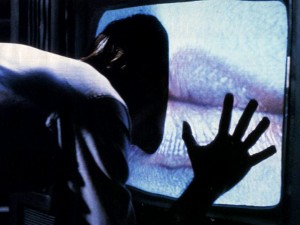Elysium and the story of Cinematic Dystopia

Thought sci-fi cinema was all about the CGI? Andrew Kirkland explores silver-screen dystopia and finds it’s the perfect way to package political and social issues…
“Everybody wants to ask me lately about my predictions for the future. No, no, no. This isn’t science fiction. This is today. This is now.”
Elysium director Neill Blomkamp’s assertion not only sums up the themes of his new release, this remark can also be used to encapsulate the vast majority of films in the dystopian film genre.
On one of the movie’s posters Matt Damon’s protagonist Max is shown in profile, head bowed, with a hi-tech exoskeleton quite literally bolted to his body, smouldering fire in the background thrown in for good measure.
Without giving the plot away, what we have is the classic ‘David versus Goliath’ blueprint which most dystopian movies adhere to: the single heroic character (or a small group of resistance fighters) attempting to defy seemingly impossible odds to bring hope to the masses amid global desolation and oppression.
Blomkamp’s insistence hits the nail on the head. Although we are supposed to be experiencing an imaginary world, the irony is that more often than not these supposed futuristic visions are based on the here and now.
A distinct parallel with present times can be made in the South African director’s debut feature, District 9 (2009), a film inspired by events during apartheid, while his latest release is packed with references to class, xenophobia and the unavailability of healthcare to those most in need.
To dismiss Elysium as trivial, shallow popcorn entertainment would be easy, but the fact of the matter is, underneath its glossy summer blockbuster facade are pertinent concerns, many of which are classic elements of cinematic dystopia.
If the history of dystopian cinema was to be given the Who Do You Think You Are? treatment, then the iconic 1927 film Metropolis would definitely be the grandfather. Presenting a terrifying vision of the world in 2026, an elitist class live in a shiny utopian glass city above ground while the suppressed workers keep everything running below.
Director Fritz Lang’s silent masterpiece was borne out of a particularly tumultuous period in history. Sandwiched between the two world wars, with a global economic meltdown on the horizon, Metropolis focused on the efforts of the few to bring down an entire system and release the enslaved workers. An idea was pounced on by Nazi propagandist Joseph Goebbels and it became the party’s call to arms for the years ahead.
There are striking similarities between Elysium and its German ancestor. In Metropolis, the audience’s sympathy immediately lies with the underground workers, who toil endlessly so that the city above runs smoothly. They are governed by the ruthless Master of Metropolis Joh Fredersen (Alfred Abel), who monitors his employees with an iron fist.
A huge explosion resulting in the death of a number of workers sets off a chain of events which has a profound effect on those above and below ground. The character of Freder (Gustav Fröhlich) is prophesied as a mediator who can bring both the ruling elite and the workers together.
The plot of Elysium features two distinct classes. The wealthy live on a utopian space station (the name of which is the film’s title), while the poor are forced to reside on an Earth ravaged by overpopulation and disease. The few from Earth who dare attempt to reach Elysium, seeking to be cured of various ailments, are met with formidable resistance from Secretary of Defense Jessica Delacourt (Jodie Foster) who is prepared to protect the celestial haven at any cost.
The film’s central character Max is involved in an accident at work where he is exposed to a large dose of radiation; he is therefore compelled to reach Elysium so his life can be saved inadvertently becoming a beacon of hope for those unable to leave Earth for a better life.
Dystopian cinema has a knack of drawing up certain political and social issues and packaging them together under the guise of futuristic entertainment. This is presumably to avoid a screenplay becoming too preachy and devaluing the thrill factor – a clever formula which has worked well over the years.
The second film adaptation of George Orwell’s novel Nineteen Eighty-Four, released in the year of the title, is viewed by many as the ultimate dystopic vision; its themes of nationalism, surveillance and censorship have had a deep and lasting effect on global popular culture.
Orwell’s literary source, written in 1949, became the touchstone for the perception of oppressive government in TV and film and was mostly based on life in Soviet Russia at the time.
In recent years, a number of dystopian films have retained the theme of resisting totalitarian governments, such as V for Vendetta (2005) and The Hunger Games (2012), but there has also been a shift towards more varied topics.
Films like The Road (2009) and The Book of Eli (2010) go down the post-apocalyptic route, whereas Moon (2009) and In Time (2011) present futures where scientific advancement has been exploited for unethical means.
Having made comparisons between the very first and the latest of dystopian films, it is interesting to note that we have come full circle, back to the issue of class and the ongoing struggle between the haves and the have-nots.
However the genre develops in the future, one thing is for sure: if you are a budding scriptwriter with an idea for a dystopian sci-fi, look no further for inspiration than switching on the evening news.
Andrew Kirkland
Elysium continues in cinemas nationwide





